
It seems as though we’ve entered the “What do I do with myself?” phase of social distancing. Over the last week or two, several billion daily routines essentially evaporated, and now each of us has to make a new one. Indoors.
The wonderful comments from last week’s post offer a glimpse into the still-forming routines of more than 500 people. A major theme is getting back to things that ground us and keep us present: reading, arts and crafts, phoning old friends, yoga, baking, and meditation.
Basically, everyone’s trying to stay healthy, sane, connected, and as helpful as they can be from home. My hope is that we’ll come out of this experience changed in exactly those ways: some degree healthier, saner, more connected and more helpful.
Not everyone has more time these days, but with everything closed, we have fewer ways to spend it. So it’s a good time to dive into home-based pursuits that make us healthier and more resilient. As one person put it, “It’s bad time for many things, but it’s a good time to read the classics, bake bread, and learn to meditate.”
I can’t help anyone with their baking goals, but I can definitely help anyone who wants to use this time to become a meditator. Given my platform and my particular skills, perhaps the most useful thing I can do for our species right now is to help some of its members finally get somewhere with meditation.
After all, it can be learned without leaving the house, it requires no equipment, and its benefits are especially pertinent right now: the ability to cultivate calm, focus, and emotional resilience in the midst of uncertainty. It can help people work better from home, and sleep better at night.
Meditation is also something you can do now — today, despite all the current restrictions on normal life – that will begin moving you towards a place of less anxiety and more clarity of mind.
Making Meditation Click
I say “get somewhere” with meditation because, while most aspiring meditators do experience some benefit, most probably don’t experience the life-changing level of calm and focus meditation is known for.
They may continue to do meditate a little, and get something out of it, but it never becomes transformative. It doesn’t have the profound quality-of-life benefits they probably hoped for when they started.
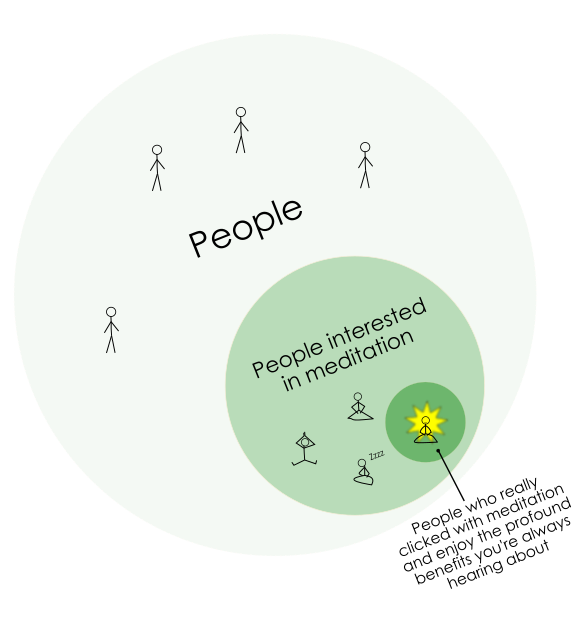
Sometimes they just didn’t stick with it long enough, which can happen with any new hobby. Just as often, though, the motivation is there, but the new meditator hits one of a few predictable (and surmountable) stumbling blocks, and only ever experiences mild benefits.
In this post, I’ll show you how to bypass those obstacles, so that you can be someone for whom meditation “clicks,” and can enjoy everything advertised in the brochure: serious calm, unmistakable equanimity, tangible concentration.
I’ll give you a map for getting past the initial beginner’s hump – that murky, uncertain realm of “Am I doing it right?” and “I think something’s happening, but I’m not sure.”
There is a place, just beyond this hump, where it’s absolutely clear that you’re doing something right. The rewards of quality meditation practice are not subtle.
Think of this post as a guide to finally “getting” meditation – to reaching that unmistakable place where you know what you’re doing, and your whole life is better for it.
Why People Get Stuck
The problem certainly isn’t lack of how-to instruction. Anyone with access to a library or the internet can find comprehensive instructions on hundreds of potent meditation techniques.
I believe the problem has more to do with how we approach the instructions, whatever the technique, and how we respond to uncertainty and doubt.
So I won’t teach a meditation technique in this post. Instead, I’ll give you an almost-foolproof method for getting somewhere with any decent meditation technique, whether it’s from a book, a course, an app, or a stray pamphlet your brother brought home from a silent retreat.
The Most Important Thing You Need to Know
Here’s what every meditation beginner needs to know, regardless of what method they’re using:
Meditation isn’t especially difficult, but you have to learn it without ever seeing how anyone else does it.
Because meditation happens inside people’s heads, there’s no way to learn it by watching others, as we do with most other things. This makes the skill of meditation seem trickier and more mysterious than it really is.
The basic skills that make up meditation techniques are actually pretty simple. For example:
- directing your attention to something
- relaxing needless tension in the body
- returning from distraction without getting upset
- noticing subtle sensations in the body and mind
- allowing experience to unfold without interfering
These skills take some experimentation and practice, but they aren’t any more difficult than the ones involved in gardening, cooking, or anything your employer has trained you to do.
However, meditation comes with this unique additional challenge — because it only happens in people’s heads, you have no way of knowing what “good” meditation looks or feels like.
There are no highlight videos of superstar meditators, performing great meditative feats. Any image you might have of effective meditation will be completely abstract, or based on tropes and stereotypes. I should feel calm, I suppose? Maybe filled with light?
It is an unusual learning situation. Meditation is a skill like any other, but it’s impossible to observe someone doing it, unless that person is you.
That means you can’t emulate anyone, and you can’t see how what you’re doing differs from other meditators. All you can do is work the instructions as you currently understand them, experimenting in good faith until you experience something truly new — perhaps profound and unusual levels of awareness and calm. Then you know you’re on the right track, and you build from there.
This is a phase all meditators must go through. I call it the “Window of Uncertainty.” It begins the moment you first sit down to meditate. It ends the moment you experience clear evidence that you’re doing something right: you feel an unprecedented state of calm, clarity, or equanimity, which leaves no question that what you’re doing is working.
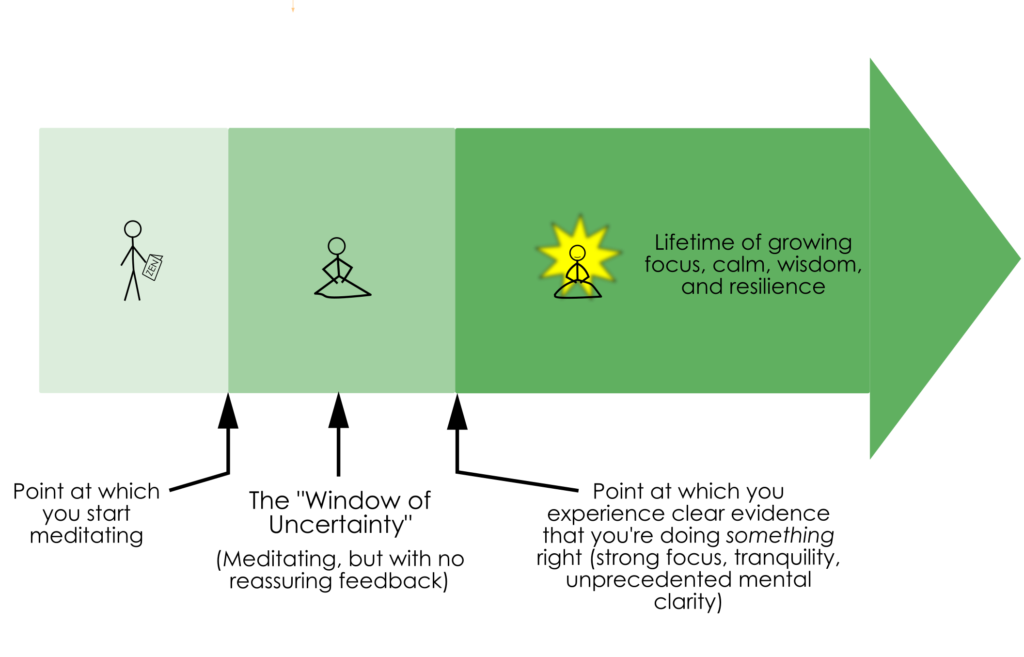
The only way to cross the Window of Uncertainty is to continue to meditate, even though you aren’t totally sure you’re doing it right.
With other skills, it’s more obvious how close you are to success, even when you’re just beginning. If you were learning to shoot a basketball, no matter how unskilled you were, you’d at least know if your shots were going in. If you were making pastries, you’d know if they taste good, and whether they look like the ones at the bakery.
With meditation, you don’t have this immediate feedback to base your adjustments on. You could be doing the technique just fine, without experiencing any immediate changes. Even for experienced meditators, concentration, tranquility, mental clarity, and other obvious signals of good practice take time to show up. That means the absence of those qualities doesn’t tell you anything, the way missed baskets or burned pastries would.
We’re accustomed to having this immediate feedback while we learn. That’s why most new meditators assume they’re making some kind of mistake unless they feel calm, focused, and equanimous.
The first thing you’ll probably notice, in your first meditation session, is that you aren’t calm or focused. Already this is a small success – you’re becoming more aware of your experience – but it feels like failure, because you don’t know what could signal success except for calm and focus.
The solution is to acknowledge this unique absence of immediate feedback, to embrace the Window of Uncertainty as an interesting part of your journey. You get to explore the unmapped mind and learn how it works, knowing that you will, sooner or later, hit on something amazing.
Mostly that means learning to refrain from trying to make yourself feel calm and focused, which is the tendency of virtually everyone at first. Instead, you simply do the practice to the best of your current understanding, and ask questions when something is particularly confusing.
That is enough to get you across the Window of Uncertainty.
Here’s what this approach looks like as a complete map:
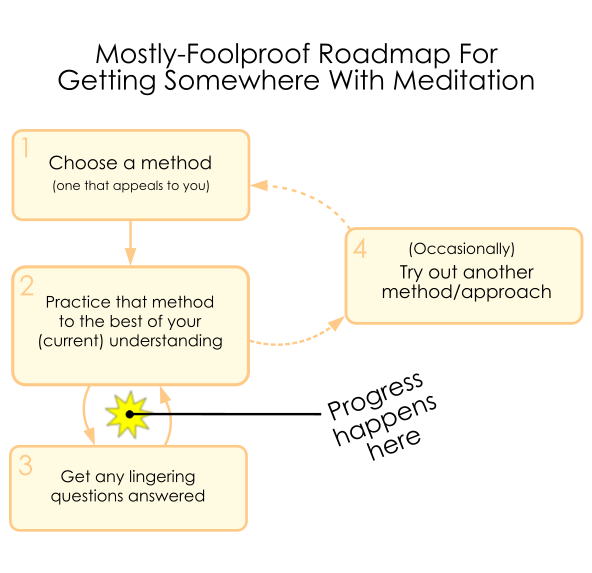
You choose a method that seems okay to you. You do it to the best of your understanding, which will naturally be a beginner’s understanding. You seek answers to your most pressing questions, which provides clarity and saves you a lot of trial-and-error work.
Doing only that, your understanding will deepen, and your practice will become more effective. Then you’ll have new questions, and so on.
At a certain point, you receive that clear feedback that confirms you’re on the right track – it becomes markedly easier to focus, background sound seems to sparkle, and you feel settled and still in a way you seldom do in ordinary life.
Congratulations. You’re over the hump and on your way.
The four steps of the roadmap can use some elaboration.
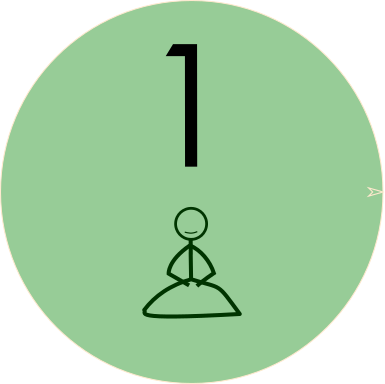
Step 1: Choose a Method
There are literally hundreds of tried-and-true meditation methods.
At first, they seem very different from each other. In one you might focus on breath sensations at the tip of the nose. In another, you recite a word in your head repeatedly, and focus on that. In some styles you leave your awareness wide open, noting whatever arises. There’s even one where you stare at a candle, then close your eyes and focus on the afterimage.
These are essentially different ways of developing the same skills and sensitivities: concentration, equanimity, and the ability to detect subtle sensory experiences. Different methods vary more in the type of language they use, and the skills they emphasize, than in what they will ultimately do for you.
In my experience, a given person will click more easily with some approaches than others. Each of us naturally resonates with different analogies, concepts, and instructional styles. When you first start, however, you have no idea which one will click the quickest for you, so don’t worry about it. Just choose a method that appeals to you.
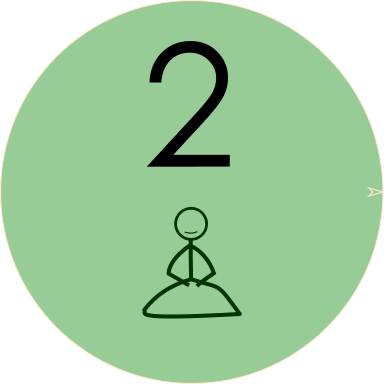
Step 2: Practice that method to the best of your (current) understanding
In meditation, because there’s no immediate feedback, beginners tend to assume they’re doing it wrong, which leads to one of two things:
- Becoming so uncomfortable with the idea of meditating wrong that they stop doing it at all
- Trying to force themselves to feel calm and focused (which is never part of the instructions)
All that’s necessary is to practice your method to the best of your understanding right now. Your level of understanding will naturally improve, as you make the inevitable little discoveries that happen with experience:
- Ah, it’s much easier to stay with the breath if I focus on it more gently.
- Ah, *that’s* what they mean when they say, ‘Allow body sensations to come and go.’
- Ah, I was tensing my legs the whole time and didn’t realize it. It’s way easier when I relax them.
Even though you may not yet be experiencing obvious states of concentration or tranquility, your skills are already improving. The next time you sit down to practice to the best of your understanding, that understanding has already improved. You’re advancing across the Window.
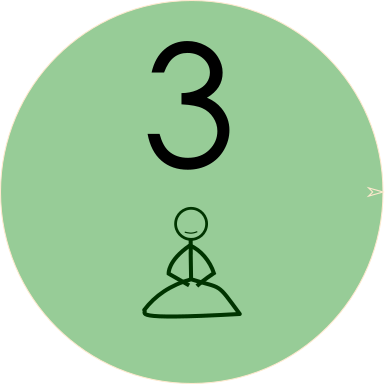
Step 3: Get your questions answered
Like any other skill, success in meditation isn’t purely a matter of following the instructions, it’s discovering what the instructions are pointing you to.
A major-league hitter could give you the most detailed instructions possible on how to hit a fastball — where to grip the bat, when to shift your weight, how to read the pitch. But the real learning happens by feeling your way into those movements, and discovering, in your own experience, what the hell he’s talking about.
However, anything he could tell you might still be extremely helpful, cutting down on what you have to figure out through trial and error. With a single question, you could eliminate a major point of confusion, and make every at-bat better — for the rest of your life.
In my experience, this is what most beginners don’t do in meditation, and I’m not quite sure why. We do it with everything else we’re trying to learn. My best piece of advice on learning meditation might be just that: seek answers to your questions.
Everyone has questions, it’s just a matter of whether they get asked.
- How do I stop thinking?
- When I focus on my body, I don’t like what I feel. What do I do?
- Is it okay to scratch an itch while I’m meditating?
Without asking questions, you’re doing a lot of unnecessary work. A person could meditate for weeks without knowing whether it’s okay to swallow their saliva during meditation. (It is, and the moment you know that, meditation becomes a far more comfortable experience.)
As for where to get answers, it depends on the source of the instructions you’re working with. If you’re working with a teacher, just ask. If you’re working from a book or a course, it might be covered in a troubleshooting section, or you might be able to email the author. Google is also surprisingly effective – most questions have been asked before, and answered online.
Belonging to a meditation community, online or offline, is very helpful for getting questions answered. There are online communities around many popular meditation books, styles, and systems, which can be found by Googling. If possible, find a community based around the style or method you are practicing, rather than meditation in general.
You can also ask me meditation questions any time, and I’ll do my best to give you a helpful answer, or point you to a place that might have one.
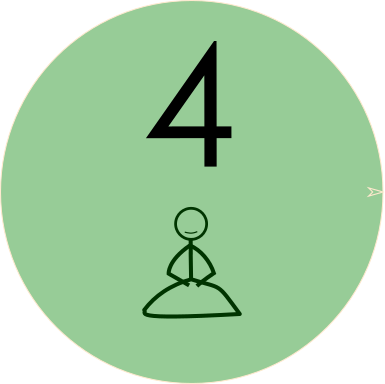
Step 4: Occasionally try out other meditation methods
For a few weeks at least, practice your chosen method at least a little every day.
Again, don’t worry about whether you’re fully “getting it.” You only need to meditate to the best of your current understanding, while making a point of getting any major questions answered.
Now and then, branch out. Try a different method, doing it daily for a while, instead of (or better yet in addition to) your first method. You might try a few guided meditations on YouTube, or perhaps you want to dive into The Mind Illuminated or another thick, comprehensive book.
Do this method in the same way: to the best of your understanding, resolving any major points of confusion by asking questions.
Expanding your repertoire of methods does two things.
Firstly, as we’ve established, different people click with different styles and modes of instruction. By trying a few different techniques, taught by different people, using different analogies and points of emphasis, you’re more likely to find the instructions best worded for your particular brain.
Secondly, any method you learn will illuminate things about every other method. All meditation instructions are ultimately just trying to get you to recognize certain truths about human experience – how your attention works, how you can relate to thoughts and feelings differently, how you can create space between stimulus and response. Your collected insights will come together like a grand puzzle. The more techniques you explore, the better you understand all the others.
The only caution here is not to try a different method every time. Give each one some exploration time.
Getting Started Today
Okay, so we’ve covered a lot.
If you would like to make use of this strange, home-bound phase of our lives to finally become a meditator, following the above roadmap virtually guarantees you will cross into meaningful results relatively quickly.
The main takeaways:
- Meditation isn’t especially difficult, it just lacks the immediate feedback we’re used to (at first)
- All you can do, and all you need to do, is practice a method to the best of your current understanding
- Asking questions can save you a lot of time
- Exploring new methods can create breakthroughs
If you’ve tried meditation before but never clicked with it, you may already have books, apps or courses you can go back to. Try them again as though they’re new, this time with the support of the roadmap.
UPDATE (April 2024):
It’s a good time to try out meditation right now, if it interests you. We’re having a one-time sale for Raptitude’s 15th anniversary. I’m offering all of my mindfulness resources, in a single bundle, for a huge discount.
That includes five things:
- Camp Calm: 30 Days of Mindfulness (course) Develop a simple, consistent meditation practice over a 30-day period.
- Camp Calm Relax: Mindfulness for Relaxation (course) Learn a meditation technique designed to promote physical and mental relaxation.
- You Are Here: A Modern Person’s Guide to Living in the Present (ebook) Explore ideas and techniques for practicing mindfulness in daily life.
- Making Things Clear: A Brief Guide for People Who Think Meditation is Hard (ebook) Learn to avoid the common ways people make meditation harder than it needs to be.
- Camp Calm Anxiety Kit (ebooklet) Three mindfulness techniques for managing anxiety.
All of these resources work as standalones. You can read the books and do the courses in any order, at any time.
Full price for the collection is over $200. As of right now you can get it all for $79 USD*. This is less than the price of Camp Calm by itself.
You’ll have lifetime access to all the material. Also, those buying the bundle will be invited to participate in future group sessions of Camp Calm, for free. There will be a group session later this year, but by then the course will be full price.
This sale will only be on for ten days, starting now, and then that’s it. After that I’m gone on a meditation retreat of my own, totally offline, so there can be no latecomers!
There are lots of ways to learn mindfulness skills – this is by no means your only chance to do that. But if you like my approach to things, this might be a good way in for you, and today might be as good a day as any to start.
***
***

Drawings by David Cain. Branch photo by Simon Matzinger.
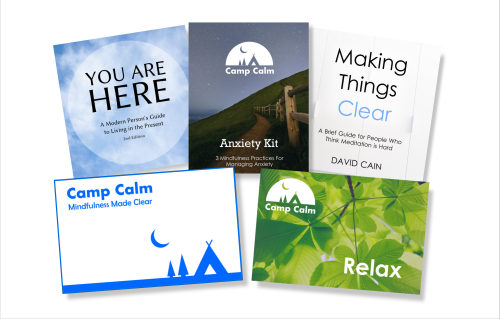
 I'm David, and Raptitude is a blog about getting better at being human -- things we can do to improve our lives today.
I'm David, and Raptitude is a blog about getting better at being human -- things we can do to improve our lives today.
Thanks for this roadmap!
I gave up meditating because it never clicked. Obviously, I got stuck in that window of uncertainty.
Now is the best time to re-start!
Great! Let me know if I can help.
This is a really a great post, highlighting some of the most common difficulties in the mindfulness/meditation practice. Especially being some one with anxiety issues, this post helps me further understand how mindfulness or inner world is so different from the outer world world.
Thanks Himanshu.
I suppose the terms “inner world” and “outer world” can be interpreted different ways, but I find it helpful not to make a distinction. It’s all just experience, and it can be attended to in the same way.
Howdy David…
I have been feeling my way around mediation for many years. Even in the beginning, when I had no idea what I was doing, I enjoyed carving out a little quiet time for myself. There were obvious benefits to doing no more than that. So I persisted, casually, and never got too hung up about whether or not I was “doing it right”. Discovering your writings gave me some tools to work with , and led to the development of a daily practice. I believe that was a huge game changer.
I recently completed your “Camp Calm Relax”course. The relaxation aspect alone is worth the price of admission.
The rest of the course provided a different method , which as you said, is most helpful.
Mediation/ Mindfulness is indeed just what the doctor ordered at the present moment.
Many thanks for another fine post!
Thanks Rocky! Carving out quiet time is the first step, and there are significant benefits to just that. Then we can work on what to do with your attention during that quiet time, and we’re already doing a practice.
David…..Thank you for this excellent guide into meditation. Your illustrative “how to” approach and steps to move along the way are greatly appreciated.
Thanks Greg. I hope you can put it to use.
Great instructions! What is working for me is the consistent practice. There are times when I was mostly distracted and frustrated while meditating. But also moments of equanimity and stillness – and it it these moments that motivate me to continue with my practice.
But what’s wonderful as well is the tremendous amount of resources out there including your course, as well as guided meditation apps that help people to achieve centredness and grounding. I turn to these resources whenever I need a wise teacher at the helm of my practice.
Yes… so the distraction is normal and necessary, because the human mind is tuned to jump around. The frustration is something we can get past pretty quickly though. It happens when we think becoming distracted is a problem. It’s just a part of the landscape, totally okay. Learning not to react negatively to distraction is one of those basic skills — once you think of it that way, frustration begins to disappear from the equation.
Thank you for this article! You certainly motivated me to give meditation an other try.
Since you encourage to ask questions, here is one that I otherwise wouldn’t have asked: How long is the window of uncertainty typically? Weeks, months, years, decades?
Good question.
It can last between one session (if you happen to randomly click with the first instructions you try, which can happen), to forever (if you stop meditating or never seek answers to your questions).
If you’re interested, willing to experiment, and you ask questions, you’d probably find traction in weeks or months, not years or decades.
The biggest factor in shortening the Window of Uncertainty is interest and curiosity. People who think there’s something interesting about the mind or meditation, aside from just the promise of eventually feeling better, tend to do well. People who are simply hunting for good feelings will be more frustrated.
Good morning David, and Folks. As usual, I skim-read and forwarded to a few people. A habit….anyhow yes. Yesterday I was going to email you and ask you to please post something! And you did. Thank you. Will read it fully, then probably forward to more folks. A few years ago, was ‘trying’ to show someone how to meditate – young gal, in her head, etc. After about 5 minutes she said to me “When will I feel good”?
I remember that often. And it ain’t about that. It takes, I think, a long long long time for most people to get what meditation is. Also love how it’s easily misspelled as ‘mediation’ – which it kind of is in a way. And yes, noticing that certain body parts are held very tightly, muscles engaged, etc. and realizing that you can let go even further, and further. And sometimes scary stuff comes up. And then, back to the breath, and the sensation or thought is over. It’s nice to have a cat or dog nearby for extra grounding and they really like when your brainwaves change….my cat starts to knead or “play the organ”…when i am in the zone. Thank you again for your thoughtfulness and just who you are.
Thanks Sharon. That’s good point — many people get caught in that trap. Meditation can do incredible things, but you can’t get to those incredible things without being mindful of what’s already happening. Quite often people are simply hunting for good feelings, which doesn’t work, because it’s not meditation!
Wow David! Perfect timing as usual! The world is exhausting right now and it’s easy to become unfocused. Thanks for the reminder and motivation at a time when we need it most.
Thanks Randy.
I feel like I got a good sense of the state of mind meditation can promote today. I did a brief metta meditation during the intro of the yoga video I did today and it completely changed the quality of the practice compared to yesterday. I was hoping that yoga would help me destress, and especially to reduce the muscle tension and tension headaches I’ve been having that last 2 weeks.
It’s fitting that it wasn’t until I let go of that expectation (for less stress & physical tension) that I was able to settle into the meditation initially, and then the mindfulness of the yoga practice. And also was able to relax and have my headache lift.
This is something I have meant to experiment with — beginning sessions with metta to help you let go of expectations and grasping. I know Leigh Brasington suggests doing even as little as 30 seconds of metta practice before beginning breath meditation, because it tunes you to be more open and less striving. I still don’t do enough metta — for a while I was doing it daily.
What a great post and excellent graphics. I found a typo though – I think you meant to say “a super fantastic course that is one of the best ever”. Can’t wait for the next season of Camp Calm.
Aw thanks Corina. As usual I’ll be inviting all alumni back to participate.
Hello and good glorious evening, David.
I didn’t introduce myself last week, but here I am. I live in Monmouth, Oregon, just north of Corvallis. I founded the Turning Leaf Foundation a couple years ago with the intention of transforming the external environment through inner growth, and sustainability. I playfully consider myself an internal environmentalist.
I appreciate what you do, David. I’ve been reading your blogs for about a year. You inspired me to start writing my own blog. I find it fulfilling and meaningful even though I have no idea how to market it or really what I’m doing! :)
I’m commenting today because as a meditation instructor and facilitator, I wanted to share a couple very helpful insights that my teacher passed on to me.
I was taught, and agree, that people typically quit meditating for one of two reasons. First, they try to meditate too long too soon. This doesn’t need much of an explanation. The best advice I got regarding this is that “you want to finish you meditation feeling like you could have gone longer.” This inspires one to return to the cushion.
The second reason is that most people don’t know why they’re meditating. Like you mentioned, there are literally hundreds of different types of meditations. And, each of them were designed to be the antidote to a very specific mental, emotional, physical or spiritual affliction. It was explained to me that if you have a headache, you’re not going to take an antacid. If you want more compassion and loving-kindness in your life, listening to relaxing waterfalls or singing bowls isn’t going to make one more compassionate. If one is struggling with being indifferent and complacent, having them do a non-judgmental mindfulness meditation can actually reinforce or exacerbate their problem. I was taught that it’s very important that the new meditator understands what it is they’re hoping to get from meditation so that they know which meditation to practice. When they use the right meditation for for what they’re hoping to accomplish or overcome, whatever it is, they will certainly see the benefits from their meditation sooner than if they are just trying out random meditations.
Please keep up all the great work! We need people like you in this world!
With Bows of Appreciation,
Dan
Hi Dan. Thanks for this. I agree with both these points, although individuals are very different and I can see there being cases on either side of both of them. Too long too soon could cause a few problems, but the one I’d worry about is quantity over quality — trying to sit for 20-30 minutes before learning how to observe a single breath, for example, and having the whole thing feel fruitless. On the other hand, many people start having breakthroughs almost as soon as they start sitting longer, and discovering that the initial flurry of resistance and self-referential thinking eases a bit. I suggest people do unusually long sittings now and then.
The discussion about benefits is tricky. I think people tend to get into meditation with one idea of what they’ll get out of it, and then discover that it benefits them in other ways once they begin experiencing the effects themselves. It can be hard to convey how, say, samadhi will benefit a person’s life, or even what it is. Clearly it’s beneficial, but nobody who doesn’t meditate is going to be pursuing it because it’s just not on their radar. Most mindfulness meditation done in the west today is derived from Buddhist meditation, which was developed with a single purpose — overcoming suffering by seeing past self-identification — which is not what most westerners get into meditation for. So I’ve found it difficult to attach clear benefits to particular meditation styles, especially since many of those hundreds of styles are aiming at exactly the same thing, only beginning with different objects/instructions. Quite often a different approach is simply a more appropriate way for a given person to cultivate the same benefits. I found open awareness meditations to be a faster route to concentration for me than strict breath-focus methods, but that says less about the meditation style than about my own mind and what it connects with. That’s why I’m a big advocate of trying more than one way, even early on.
Anyway, there’s so much to say about benefits as they relate to styles. What we seek and what we find in meditation are different things, but I agree with the overall point that people need to know why they’re meditating.
Thank you so much, David! This addresses beautifully the roadblocks for so many. I’ve experimented with a lot of techniques. I undoubtedly experience benefits, but it took a lot of trial and error and repetition to get there. Fortunately, I was curious and would have occasional moments of grace that kept me returning to practice. Wish I had had this way back then! I’ll be sharing this widely. Thank you again.
Curiosity is probably most important quality. It will get you through the awkward parts, for sure, and it also keeps you interested in the possibilities…Can I feel this without pushing it away? What is this sensation really, when I look at it closely? Curiosity fuels everything you need to do in meditation — the looking, the investigating, the excitement of what’s to come.
This is a truly wonderful encouragement – well written and nuanced. Thank you David :)
I’m guessing I would have given up on meditation quickly if not for my good fortune to land myself in residential practice at a zen buddhist temple. Because at the time I had a pretty grim view of humanity, I was surprised to be so inspired by the people in that community. Especially the older people.
I perceived a certain quality shared by many of the elders, people who had been meditating regularly for years, decades: they seemed able to really listen, and really see, feel, and sense, in a way that I knew I wasn’t. There was an awesome immediacy to their attention; I felt like when I was around them things mattered more. What I was saying, whether I was paying attention; the way I washed the dishes…
So, what’s true for me: having teachers (as, I think, David suggested) is very important. They model the ‘effects’ of meditation every moment of the day. They don’t really have to do anything special. It was life-changing for me just to see people in their old age so active, inspired, generous – everything I thought old age wasn’t.
May we all find contentment in our breath, right here ;)
Spectacular post, and timely too! Thank you for helping to bringing this knowledge to everyone, in such a non-denominational, approachable and scientific format!
I started with Zen mediation and found other techniques as I explored Yoga and mindfullness practices. Branching out helped me understand that it all roads gets you to the same place!
Very informative piece :)
Meditation works wonders. You just need to gather determination to get started and then there is no looking back.
Congrats for creating this awareness.
Quite an interesting and eye-opener piece of writing. Wonderful reading with many takeaways. Meditation helps in connecting to the inner self. I started practicing Nirvana fitness which is like meditation with movements, with deep breathing techniques, deep meditative music and intentions.
Comments on this entry are closed.
{ 6 Trackbacks }